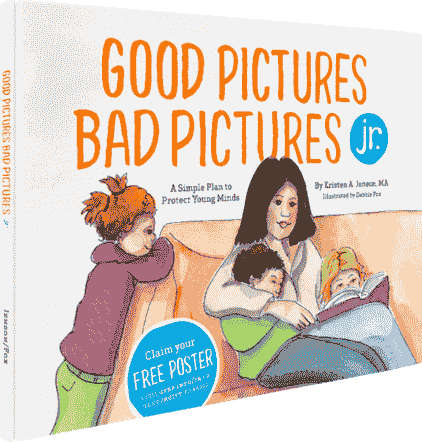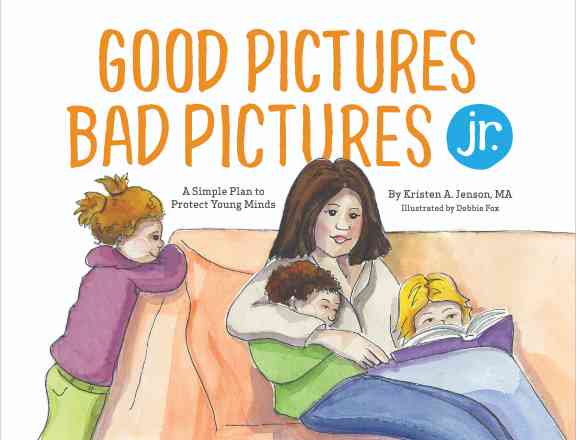
Sexual Behavior in Children: What's Normal? What's Harmful?
This post was originally published on April 27, 2017 and updated on April 4, 2019 and November 3, 2022.
Playing “doctor” is a common sign of normal curiosity in children. Little girls and little boys want to see each other’s private parts. That’s pretty harmless when you’re dealing with 5-year-olds. But what happens when a 10-year-old boy cajoles a 7-year-old girl into a bathroom and wants to put their private parts together? That’s no longer playing doctor--that’s called child-on-child harmful sexual behavior.
It’s important for parents to recognize the differences between normal and harmful sexual behaviors in kids. And to understand why child-on-child harmful sexual behavior is increasing (hint, hint: porn has something to do with it). Thankfully, resources exist to help children who are victims of sexual abuse AND children who have acted out sexually on other children.

What is normal sexual behavior in children?
As I mentioned above, some kids engage in normal play involving the sexual parts of their bodies. Here are some of the behaviors that are normal for kids:
- Playing exploratory “doctor” games in which they look at or touch one another’s private parts
- Touching their own genitals
- Being curious about nudity
First, it’s important to note that normal childhood exploratory behaviors are spontaneous (meaning they are not planned) and between kids of a similar age. Learn more about childhood sexual development here.
Second, a child expressing normal behavior generally responds to adult intervention. For example, young children with normal behaviors will keep their clothes on during play when reminded by their teachers or caregivers.
Here’s an example of normal sexual play provided by the National Center on the Sexual Behavior of Youth:
Two brothers, ages 7 and 9, are getting dressed in their bedroom. Things get quiet and their mom comes in to find that they are undressed and touching each other’s genitals. It’s shocking to her, but she later learns that it was unplanned and not forced. They explained that they were just wondering what it would feel like to touch each other. Her husband asks the boys to get dressed and then has a private one-on-one talk with them about appropriate touching and privacy.
What is harmful sexual behavior in kids?
Harmful sexual behaviors in children generally include at least one of the following elements:
- Takes place between children at least two or more years apart in age
- Behavior continues despite parenting strategies (such as discipline)
- Causes harm or potential harm (physical or emotional)
- Simulates adult sexual acts or sexual acts popularized in pornography
Here are some examples of harmful sexual behavior in children:
- Imitating sexual intercourse with toys, pets, or other children
- Putting objects in sexual body parts
- Repeatedly displaying sexual body parts or masturbating in public
- Oral genital contact
- Sexual behavior with kids who are 4 or more years apart in age
- Forced sexual behavior of any kind
- Persistent, secretive sex play that continues after adult intervention
If your child has been exhibiting concerning or harmful sexual behaviors, be sure to check out our four part series on child-on-child harmful sexual behavior, where an expert on the subject gives step-by-step advice on how to handle the situation. You can find Part 1 here.
We also recommend you review the advice from the National Center on the Sexual Behavior of Youth, especially the information in the Parents section. Depending on the severity of the behavior, therapy may be required, as well as intervention by Child Protective Services or your local Child Advocacy Center.
However, when problems are recognized and treated early, most children respond well and do not continue acting out sexually with other kids. In other words, most children who offend on other children do not grow up to be pedophiles, especially if they receive evidence-based treatment.
Related:
Child on Child Harmful Sexual Behavior Part 1: A 3-Step Path to Prepare Parents
The 3 Big Red Flags of Sexual Abuse

Child-on-child harmful sexual behavior on the rise
Professionals who work with children are noticing that child-on-child harmful sexual behavior is taking a disturbing trend upwards. And many have come out and exposed the link between more access to pornography and more sexual abuse between children.
In fact, Defend Young Minds (formerly Protect Young Minds) recently helped to sponsor a symposium on this topic in Washington, D.C. put on by the National Center on Sexual Exploitation. Several speakers, including myself, connected the dots between children watching pornography and then imitating the sexual behavior they see on other more vulnerable kids.
As states begin to document these cases, the numbers skyrocket. For example, Missouri was shocked by its own data after they passed a bill requiring the state to assess all complaints of children with harmful sexual behaviors. Experts believed the first year would bring in about 600 cases, but in fact more than 2,000 cases were reported in the first five months!
In Alabama, WVTM News reported that a local child advocacy center also had record high numbers of child-on-child sex abuse cases. A spokesperson stated,
We had (cases) that the child has said, ‘I learned that from the internet,’ and we've had children that are basically describing an addiction to child pornography and then they try it out … We had a case recently where the victim is only 3 years old and the [sexually aggressive child] is only 10 or 11 years old …
Related: Sexual Assault Expert Warns of Heartbreaking Trend Among Children
Professionals are concerned about kids
Defend Young Minds spoke to a forensic interviewer who works for a different children’s advocacy center. She confirmed the same trend: a significant rise in the number of children being referred to them for problem sexual behaviors.
Most of these kids have been exposed to pornography, and have also been compulsively watching it -- seeking it out when told not to, taking big steps to hide it, and even strategically planning ways to get access to parents' phones. One child who exhibited these behaviors was only 6 years old.
The forensic interviewer told us that her office is seeing a “tidal wave” of kids who are acting out sexually after viewing pornography. Employees of the advocacy center are “stressed out” and terrified of the ramifications of this new trend.
According to the U.S. Department of Justice, juveniles are the offenders in 40 percent of child sexual abuse cases involving victims under the age of 6. Because so many cases go unreported, that number is likely much higher.
Related: 5 Body Safety Rules Every 5-Year-Old Should Know
[[CTA]]
How to respond and help children
What to do if your child has been sexually victimized:
- If you suspect any child had been abused, call the National Sexual Assault Hotline at 800.656.HOPE (4673) or chat online at online.rainn.org.
- Contact your local Child Advocacy Center. This allows for a forensic interview with the child that will be conducted by trained specialists in an age-appropriate manner.
- If you suspect that your child was the victim of penile penetration, please consider taking the child immediately to a hospital emergency room that staffs SANE (sexual assault nurse examiner) nurses to do an exam. This will be your best option for collecting evidence, but it needs to be done quickly.
- Help your child heal from trauma. Get professional help if needed.
What to do if your child hurts another child with harmful sexual behavior:

This is the best advice from the National Center on the Sexual Behavior of Youth:
- Try to stay calm, although there is no “right” or “wrong” initial response.
- Reassure your child that you care for them.
- Remind yourself that you are not alone.
- Find social and professional support.
More excellent advice can be found on their website, including a Safety Plan.
The way children are treated or prosecuted varies from state to state. We join with the NCSBY in advocating for treatment of children who exhibit harmful sexual behavior, not just punishment.
Most importantly, help prevent such traumatic experiences by preparing and protecting kids from sexual abuse and also being clear about appropriate behavior toward other children. We CAN make a difference in the lives of kids today!



Good Pictures Bad Pictures Jr.
“I highly recommend this book to all people with children. A must have for all parents!” —Amazon Review







